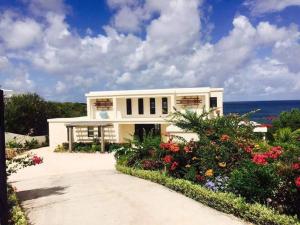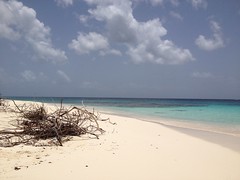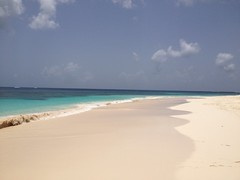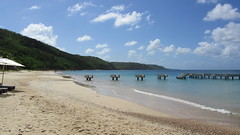Anguilla
Anguilla (English: /æŋˈɡwɪlə/) is a British Overseas Territory in the Caribbean. It is one of the most northerly of the Leeward Islands in the Lesser Antilles, lying east of Puerto Rico and the Virgin Islands and directly north of Saint Martin. The territory consists of the main island of Anguilla, approximately long by wide at its widest point, together with a number of much smaller islands and cays with no permanent population. The territory's capital is The Valley. The total land area of the territory is , with a population of approximately .
Etymology
The native Arawak name for the island was Malliouhana.
In reference to the island's shape, the Italian , meaning "eel" (in turn, from the Latin diminutive of anguis, "snake") was used as its name.
History
Anguilla was first settled by Indigenous Amerindian peoples who migrated from South America. The earliest Native American artefacts found on Anguilla have been dated to around 1300 BC; remains of settlements date from AD 600. There are two known petroglyph sites in Anguilla: Big Spring and Fountain Cavern. The rock ledges of Big Spring contain over 100 petroglyphs (dating back to AD 600-1200), the majority consisting of three indentations that form faces.
Precisely when Anguilla was first seen by Europeans is uncertain: some sources claim that Columbus sighted the island during his second voyage in 1493, while others state that the first European explorer was the French Huguenot nobleman and merchant René Goulaine de Laudonnière in 1564. The Dutch West India Company established a fort on the island in 1631. However, the Company later withdrew after its fort was destroyed by the Spanish in 1633.
Traditional accounts state that Anguilla was first colonised by English settlers from Saint Kitts beginning in 1650. The settlers focused on planting tobacco, and to a lesser extent cotton. The French temporarily took over the island in 1666 but returned it to English control under the terms of the Treaty of Breda the next year. Major John Scott who visited in September 1667, wrote of leaving the island "in good condition" and noted that in July 1668, "200 or 300 people fled thither in time of war". The French attacked again in 1688, 1745 and 1798, causing much destruction but failing to capture the island.
It is likely that the early European settlers brought enslaved Africans with them. Historians confirm that African slaves lived in the region in the early 17th century, such as slaves from Senegal living on St Kitts in the mid-1600s. By 1672 a slave depot existed on the island of Nevis, serving the Leeward Islands. While the time of African arrival in Anguilla is difficult to place precisely, archival evidence indicates a substantial African presence of at least 100 enslaved people by 1683; these seem to have come from Central Africa as well as West Africa. The slaves were forced to work on the sugar plantations which had begun to replace tobacco as Anguilla's main crop. Over time the African slaves and their descendants came to vastly outnumber the white settlers. The African slave trade was eventually terminated within the British Empire in 1807, and slavery outlawed completely in 1834. Many planters subsequently sold up or left the island.
During the early colonial period, Anguilla was administered by the British through Antigua; in 1825, it was placed under the administrative control of nearby Saint Kitts. Anguilla was federated with St Kitts and Nevis in 1882, against the wishes of many Anguillans. Economic stagnation, and the severe effects of several droughts in the 1890s and later the Great Depression of the 1930s led many Anguillans to emigrate for better prospects elsewhere.
Full adult suffrage was introduced to Anguilla in 1952. After a brief period as part of the West Indies Federation (1958–62), the island of Anguilla became part of the associated state of Saint Kitts-Nevis-Anguilla with full internal autonomy in 1967. However many Anguillans had no wish to be a part of this union, and resented the dominance of St Kitts within it. On 30 May 1967 Anguillans forcibly ejected the St Kitts police force from the island and declared their separation from St Kitts following a referendum. The events, led by Atlin Harrigan and Ronald Webster among others, became known as the Anguillan Revolution; its goal was not independence per se, but rather independence from Saint Kitts and Nevis and a return to being a British colony.
With negotiations failing to break the deadlock, a second referendum confirming Anguillans' desire for separation from St Kitts was held and the Republic of Anguilla was declared unilaterally, with Ronald Webster as president. Efforts by British envoy William Whitlock failed to break the impasse and 300 British troops were subsequently sent in March 1969. British authority was restored, and confirmed by the Anguilla Act of July 1971. In 1980, Anguilla was finally allowed to formally secede from Saint Kitts and Nevis and become a separate British Crown colony (now a British overseas territory). Since then, Anguilla has been politically stable, and has seen a large growth in its tourism and offshore financing sectors.
Geography and geology
Anguilla is a flat, low-lying island of coral and limestone in the Caribbean Sea, measuring some 16 miles (26 km) long and 3.5 miles (6 km) in width. It lies to the east of Puerto Rico and the Virgin Islands and directly north of Saint Martin, separated from that island by the Anguilla Channel. The soil is generally thin and poor, supporting scrub, tropical and forest vegetation. The terrain is generally low-lying, with the highest terrain located in the vicinity of The Valley; Crocus Hill, Anguilla's highest peak at , lies in the western regions of the town.
Anguilla is noted for its ecologically important coral reefs and beaches. Apart from the main island of Anguilla itself, the territory includes a number of other smaller islands and cays, mostly tiny and uninhabited:
- Anguillita
- Blowing Rock
- Dog Island
- Little Scrub Island
- Prickly Pear Cays
- Scrub Island
- Seal Island
- Sombrero, also known as Hat Island
- Sandy Island
- Scilly Cay
Geology
Anguilla (and the wider Anguilla Bank) is of volcanic origin, lying on the Lesser Antilles volcanic island arc, and tuffs and volcaniclastic breccias of Eocene age are exposed locally on the island. The island was largely submerged during the Miocene, leading to the formation of the reefal limestone Anguilla Formation, which was subsequently tectonically uplifted and cover most of the island today. Since the late Pleistocene, however, Anguilla has undergone tectonic subsidence at a rate of around 1-2mm/yr.
Governance
Defence
As a British overseas territory, the UK is responsible for Anguilla's military defence, although there are no active garrisons or armed forces present in the territory. Since 2020, the Royal Navy has forward-deployed the offshore patrol vessel HMS ''Medway'' long-term to the Caribbean for patrol and sovereignty protection duties.
Anguilla had a small marine police force, comprising around 32 personnel, which operated one VT Halmatic M160-class 52-foot fast patrol boat. Policing on the island is the responsibility of the Royal Anguilla Police Force.
Population
Demographics
The majority of residents (90.08%) are black, most of whom are the descendants of enslaved people transported from Africa. Minorities include whites at 3.74% and people of mixed race at 4.65% (figures from 2001 census).
72% of the population is Anguillan while 28% is non-Anguillan (2001 census). Of the non-Anguillan population, many are citizens of the United States, United Kingdom, St Kitts & Nevis, the Dominican Republic, Jamaica and Nigeria.
2006 and 2007 saw an influx of large numbers of Chinese, Indian and Mexican workers, brought in as labour for major tourist developments due to the local population not being large enough to support the labour requirements.
Religion
Christian churches did not have a consistent or strong presence during the initial period of English colonisation; spiritual and religious practices of Europeans and Africans tended to reflect their regional origins. As early as 1813, Christian ministers formally ministered to enslaved Africans and promoted literacy among converts. The Wesleyan (Methodist) Missionary Society of England built churches and schools from 1817.
According to the 2001 census, Christianity is Anguilla's predominant religion, with 29% of the population practising Anglicanism; another 23.9% are Methodist. Other churches on the island include Seventh-day Adventist, Baptist, Roman Catholic (served by the Diocese of Saint John's–Basseterre, with the See at Saint John on Antigua and Barbuda) and a small community of Jehovah's Witnesses (0.7%). Between 1992 and 2001, the number of followers of the Church of God and Pentecostals increased considerably. There are at least 15 churches on the island. Although a minority on the island, Anguilla is an important location to followers of Rastafarian religion as the birthplace of Robert Athlyi Rogers, author of the Holy Piby which had a strong influence on Rastafarian and other Africa-centre belief systems. More recently, a Muslim cultural centre has opened on the island.
| Religion | 1992 | 2001 | 2011 |
|---|---|---|---|
| Anglican | 40.4 | 29.0 | 22.7 |
| Methodist | 33.2 | 23.9 | 19.4 |
| Pentecostal | – | 7.7 | 10.5 |
| Seventh-day Adventist | 7.0 | 7.6 | 8.3 |
| Baptist | 4.7 | 7.3 | 7.1 |
| Catholic | 3.2 | 5.7 | 6.8 |
| Church of God | – | 7.6 | 4.9 |
| Jehovah's Witnesses | – | 0.7 | 1.1 |
| Rastafarian | – | 0.7 | |
| Evangelical | – | 0.5 | |
| Plymouth Brethren | – | 0.3 | 0.1 |
| Muslim | – | 0.3 | |
| Presbyterian | – | 0.2 | 0.2 |
| Hindu | – | 0.4 | |
| Jewish | – | 0.1 | |
| None | – | 4.0 | 4.5 |
| Other | 10.7 | 3.5 | |
| Not stated | 0.7 | 0.3 |
Languages
Today most people in Anguilla speak a British-influenced variety of standard English. Other languages are also spoken on the island, including varieties of Spanish, Chinese and the languages of other immigrant communities. However, the most common language other than Standard English is the island's own English-lexifier Creole language (not to be confused with Antillean Creole ('French Creole'), spoken in French is…
Hotels Anguilla
 Anguilla Sunset Beach HouseCrocus Hill
Anguilla Sunset Beach HouseCrocus Hill Sandcastle Villa & Beach HouseThe Valley
Sandcastle Villa & Beach HouseThe Valley Tropix Getaway - rental car availableCrocus Hill
Tropix Getaway - rental car availableCrocus Hill Zemi Beach House, LXR Hotels & ResortsShoal Bay Village
Zemi Beach House, LXR Hotels & ResortsShoal Bay Village Aurora Anguilla Resort & Golf ClubEbenezer
Aurora Anguilla Resort & Golf ClubEbenezer Sandcastle Beach HouseThe Valley
Sandcastle Beach HouseThe Valley Sandcastle VillaCrocus Hill
Sandcastle VillaCrocus Hill CeBlue VillasThe Valley
CeBlue VillasThe Valley
Looking for places related to Anguilla?
Those are other destinations to find places related to Anguilla:
- Sint Maarten
- Antigua
- Anguilla
- Nelson's Dockyard
- Isla de Anguila
- Princess Juliana
- Nevis
- Buck Island Reef Na…
- Saint Kitts
- Mount Liamuiga
- Soufrière Hills
- Prickly Pear Cays
- Scrub Island
- Sint Eustatius
- Barbuda
- V. C. Bird
- St. John's Cathedral
- Clayton J. Lloyd
- Cap Juluca Hotel
- Sir Vivian Richards…
- Gustaf III
- Dog Islands
- Robert L. Bradshaw
- Antigua Recreation …
















